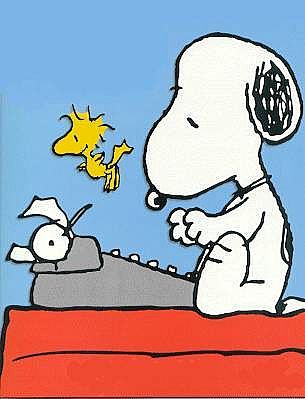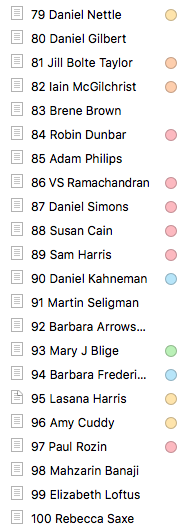I’m knee-deep in a big writing project with a really tight deadline. Perhaps during peak #nanowrimo I was banking more raw words, but this project is asking for a finished product rather than a first draft. I’m certain that for me this is a new level of text generation and re-tooling, and thought I’d share the process that seems to be working in getting it done.

Note that my current project is non-fiction and requires research, my process may not generalise to other forms. Also, it’s very structured, even modular – 100 pieces, each on a different topic – and the process reflects this. That said, all longer-form writing benefits from a level of structure, so you don’t need to swim around in mud more than is absolutely necessary. Maybe on another occasion I’ll write about developing concepts and structure – and on the far side of the process, dealing with revisions from editors or collaborators; this is about generating content and bringing it to a submittable state.
So. I have a bunch of sections and I know what topics they need to cover. I put this structure straight into Scrivener, but you could use the free Apple Notes, Evernote, a text document with folding, or I suppose a Google/Word document with a TOC. I recommend something where all of your content will be in one place but it’s easy to just focus on one part at a time; you want to be mostly undistracted, but from time to time will need to quickly reference something from elsewhere, even for a project as modular as mine (if not, I question whether you are working on a single piece of work at all).

You can see how it’s easy to gloss which sections precede and follow the one I’m working on. Plus Scrivener tagging and searches makes it easy to locate sections on the same topic, see where I’ve made another reference to the figure, etc.
Now I have produced the skeleton, I need to put some flesh on it. I do this in rounds of work.
The first round is nothing to something.
What it is: doing the reading and note-taking needed to produce the primordial soup for a draft. There will surely be more research needed, but that will be to plug gaps; this is the raw material. In some cases I it may spill into an approximate first draft but one characterised by half-finished paragraphs and sentence scraps. Scrivener makes it easy to keep the research in a notes folder tied to the section, and to store references via hyperlinks or even shortcuts to local files (eg pdfs, images).
What it feels like: rabbitholing (on a leash). Go to the obvious sources and allow yourself to slip further through hyperlinks, or actively search references that intrigue you. Allow yourself to make associations even if you can’t put them into words. Enjoy rabbitholing. Make sure to copy paste as you go. But tug the leash periodically – is this still contributing to your understanding of this topic? If not, go back to the obvious sources again. For me, these are always the wikipedia bio, their core books/articles, and interviews.
Sometimes however you may need to suck it up and concentrate – especially for my work, sometimes I have to read a basic neuroscience paper from start to finish.
The next is something to first draft.
What it is: making a first draft. This can be a really bad first draft! I allow myself to use words and phrases repetitively, complete sentences I don’t have the energy for with BLA BLA BLA or CHECK THE EXACT CLAIM SHE MADE, have a crappy and cliche beginning and end. It can also be huge – even twice the word limit I’m working to. But it recognisably looks like a series of paragraphs telling a story.
What it feels like: storytelling. I have all this fun, stuff that I like about the topic, and now it’s ordering it to highlight and prioritise it. It’s drawing a narrative about it, and making some hard decisions on what stuff doesn’t make the story after all, and what stuff is strictly auxillary (and may be dropped later).
Following this is first to second.
What it is: here, I’m radically punching up the writing and the specifications. If the piece needs to be 250 words (as it does for the project I’m working on) then it needs to be within whistling distance now, 240-280. This is a draft that, if I had to, I could submit without feeling like an idiot. This might involve a bit of the technique I describe in the next round, if it’s obviously needed.
What it feels like: editing. At the moment this tends to feel like the easiest round, as the shaping of the storytelling has been achieved, and the final pressure of completeness is yet to come. With time passed since the first draft, issues that seemed hard to tackle (the BLA BLAs) are now little tasks to bite off, and the really shoddy bits become obvious wounds you are moved to heal.
Lastly, second to submittable.
What this is: This is about quality, pure and simple. Currently I approach this in a way similar to JBP’s recommendation: break every sentence onto a different line and try and better each one with a second version. This might also result in reordering content, combining sentences together, but the core idea is that the previous round should have got us to coherent territory, so the priority is just making everything as clear as possible.
What it feels like: amendment. As in making amends. This is where insidious sentences suddenly reveal themselves, and I often am coming face to face with my own hidden callowness. This is because often when things are unclear or clunky it’s because I’m hiding the fact that I’m not totally sure of something – the facts, my argument, my confidence in sharing my opinion. So I have to take a few steps back, do some more research, and get the thoughts clear in my head.
—-
I use labels and colour-codes to know where I am with each section, as you can see in the view below. Scrivener also does smart searches so I can have a view of only my blue (2nd draft) documents, etc, which is handy for getting a quick lay of the land.

For any given section on any given day, I attempt one step. Even if I am really on a roll on first contact with a section, and kick it into a decent shape, I don’t conclude it’s gone from nothing to second draft; it’s just a good something. It’s still going to have three more rounds of attention before it’s done. This may be a fiction, but it’s a helpful one: otherwise when I embark on a piece a little bird in my head is going to say “cmon, time is short, can’t you expedite these ones a round or two? Just have to get it really right, right now…” and that’s counter to my process. And mostly it’s not that much of a fiction; next time around, I find it’s not as good as I thought, and the luxury of three more rounds (rather than one) to perfect it means that I can enjoy what goodness there is rather than feel stressed by its limitations.
Note that one round never counts as more than one round, but it can count as less: if I make a stab at a first draft and then get called away before I’m satisfied, it ain’t a first draft, I don’t change the colour code, it’s not ticked off my list. I try to avoid this, but I don’t want to create problems for myself later on.
I was chatting to someone this week who took a very different approach to me: they research, outline, and then fill out the outline – done. So in their case, they can’t come across the insidious sentences so late in the day, and avoid the risk of substantial rewrites. There is an obvious advantage to this, but the downside is that this painstaking approach is itself very slow and careful. I find attacking the page gets me momentum that’s incredibly valuable. For example, today I spent around 5 hours of writing, and hit:
2 rounds of nothing to something (a bunch of notes)
5 rounds of “something to first“ (1,250-2,000 words)
3 rounds of “first to second” (editing 750-1200 words)
2 of “second to submittable“ (editing 500 words)
Which is a lot of content for me. [edit: I’ve finished this process and during peak days – where I was in writing mode basically the whole day – I pulled off up to 24 sections, which is crazy beyond anything I have ever come close to]
I’ve been recently researching creativity guy Edward de Bono and reminded of his Creative Hats, and I think my approach echoes his idea of separating out the mental modes of engagement so you can get the best of each of them. I think everyone agrees on “do a shitty first draft” and that later editing should be more severe, but I think there’s actually more to explore than just that. Hopefully, this post has given some insight into what.
One Reply to “From concept to submission: getting non-fiction writing done”